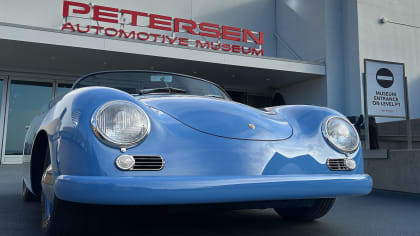40 YEAR OLD VIRGIN
The VW Golf is 40 years young
This article is from our archives and has not been updated and integrated with our "new" site yet... Even so, it's still awesome - so keep reading!
Published on Sun, May 4, 2014
By: The LACar Editorial Staff

Great design never ages
The Golf celebrates its 40th birthday this year. Quite a milestone for one of the biggest selling cars of all time, with over 30 million sold to date, and to mark this auspicious anniversary, we thought we’d take a closer look at this classic car’s biography. We’ve invited VW expert Ian Cushway from UK classic parts firm VWHeritage to treat us to a little history.
By Ian Cushway
Can it really be four decades ago that this water-pumped newbie was first rolled off the Wolfsburg production line on March 2, 1974?
Initially, it was quite a struggle for the numerous contracted designers to break free of the iconic curved and rounded Beetle form. Ultimately, Giorgetto Giugiaro managed it, and the wait was worthwhile. A cool, boxy, geometrical hatchback emerged, with a front-wheel drive and a transversely mounted water-cooled engine tucked tidily under the bonnet.
The legendary Beetle was not an easy act to follow and the press launch in May and June of 1974 reflected such huge expectations. Over 21.5 million Beetles had been built. But VW needn’t have worried. Such was the demand that within just 19 months of its launch one-million Rabbits had already been produced. The stylish and compact design and clever use of space quickly won over the market.

The Rabbit GTI was launched in 1976, and this started a trend for hot hatches that still exists today. The Rabbit D (naturally aspirated diesel engine, 1976) and then soon after, the Rabbit GTD (turbodiesel, 1982) both marked a crucial advance for diesels in the small hatch market. The Rabbit Cabriolet was introduced in 1979, on occasion enjoying the top spot on the international list for best-selling Cabrio.
August 1983 saw the release of the more practical Golf Mk2. Heavier and roomier, the car included some appealing state of the art features such as ABS, power steering and rust proof, wax dipped shells. Though it kept the original Giugiaro designed lines of its predecessor, the new VW in-house designed shape was more rounded. The 1986 Syncro model presented the first four-wheel drive in the Golf class.
The arrival of the third generation Golf in August 1991 heralded a new era of safety. Technological advances in the body construction meant crash safety was improved dramatically and the first front airbags were introduced in 1992.
It may not have been as sexy and exciting as the Mk1 and Mk2 but other innovations made up for that: the first six cylinder engine (VR6), oxidation catalytic converter for diesel engines, cruise control (1991) and in 1993, the first direct injection TDI, and ABS, (which by 1996 had become standard in all Golfs).

In 1993, VW rolled a new convertible, based on the Mk3,off the production line, as well as the first Golf Variant (Estate) and an all-wheel drive model (Syncro II).
By 1998, Hartmut Warkuß was the head of design at VW and responsible the creation of the Golf Mk4. This year also saw the first appearance of ESC (Electronic Stability Control) which became a standard feature in Germany the following year. 1998 also marked the arrival of the first all-wheel-drive Golf with a Haldex clutch – the Golf 4MOTION. Additional safety features, such as the first direct-injection engine (FSI) and the standard head airbag (window airbags) followed in 2002, the same year that VW launched the R32, with a top speed of 155mph and an innovative dual-clutch DSG gearbox.
In 2003 the Golf Mk5 made a dynamic entrance onto the scene and sped past all its competitors with new levels of comfort and a lively performance plus state of the art security features. Laser-welded bodywork was further stabilised by a 35 per cent increase in torsional stiffness. The Golf also now became available with a total of eight protective air buffers, six standard airbags (front, side front and window) and an extra two side airbags were optional. With the new four-link rear suspension, seven-speed DSG, bi-xenon headlights, panoramic sliding sunroof, plus the world’s first twincharger (in the 2006 TSI), combining turbo- and supercharger the Golf Mk5 outstripped previous models in terms of power and luxury. Then, in 2006, the Golf Plus made its debut, and in 2007, the CrossGolf, a new Estate, as well as the super fuel-efficient Golf BlueMotion (62.8 mpg).
By the end of July 2012, based on the sixth generation Golf launched in 2008, a whopping 2.85 million had been produced. Safety continued to be top priority and the car flew through the EuroNCAP crash test, gaining the maximum five stars.

More TSI engines were made and the turbodiesel engines (TDI) were changed from unit injection to the common rail system which meant better performance and fuel efficiency: the second Golf BlueMotion was capable of an impressive 74.3mpg, equivalent to 99g/km of CO2. The new Light Assist automatic main beam management and Park Assist systems made the sixth generation VWs most advanced Golf yet. Volkswagen celebrated the world premiere of the seventh generation Golf on 4 September 2012. The new Golf was 100kg lighter which reversed the frequently cited upward weight spiral. Consequently, fuel economy was improved by up to 23 per cent: the new Golf TDI BlueMotion could pull off 88.3mpg on a good run. Plus, Volkswagen fitted the new Golf up with a whole range of assistance systems – both as optional and standard. And in 2014, VW launched their electric Golf with an impressive range of around 190km. The latest in this auspicious line-up is the Golf GTE hybrid, set for launch in Fall 2014. It’s important to honor a great car with a biographical time-line such as this, but in the end, for many of us older VW fans, the Mk1 and Mk2s will always be the stand-out cars, and perhaps, our personal favourites.




